NCERT solutions for Class 9 Science, Chapter 7, "Motion".
This chapter of Class 9 Science, "Motion," combines students with not only the types of motion but also the principle basics of the law relating to it. A few general concepts with which the chapter deals include different types of motion and laws describing motion characteristics of objects.
Download PDF For NCERT Solutions for Science Motion
The NCERT solutions for Class 9 Science, Chapter 7, "Motion". are tailored to help the students master the concepts that are key to success in their classrooms. The solutions given in the PDF are developed by experts and correlate with the CBSE syllabus of 2023-2024. These solutions provide thorough explanations with a step-by-step approach to solving problems. Students can easily get a hold of the subject and learn the basics with a deeper understanding. Additionally, they can practice better, be confident, and perform well in their examinations with the support of this PDF.
Download PDF
Access Answers to NCERT solutions for Class 9 Science, Chapter 7, "Motion".
Students can access the NCERT solutions for Class 9 Science, Chapter 7, "Motion".. Curated by experts according to the CBSE syllabus for 2023–2024, these step-by-step solutions make Science much easier to understand and learn for the students. These solutions can be used in practice by students to attain skills in solving problems, reinforce important learning objectives, and be well-prepared for tests.
Motion
A trolley, while going down an inclined plane, has an acceleration of 2 cm s-2. What will be its velocity 3 s after the start?
Given, initial velocity (u) = 0 (the trolley begins from the rest position)
Acceleration (a) = 0.02 ms-2
Time (t) = 3s
As per the first motion equation, v=u+at
Therefore, terminal velocity of the trolley (v) = 0 + (0.02 ms-2)(3s)= 0.06 ms-1
Therefore, the velocity of the trolley after 3 seconds will be 6 cm.s-1
A racing car has a uniform acceleration of 4 m s-2. What distance will it cover in 10 s after start?
Given, the car is initially at rest; initial velocity (u) = 0 ms-1
Acceleration (a) = 4 ms-2
Time period (t) = 10 s
As per the second motion equation, s = ut+1/2 at2
Therefore, the total distance covered by the car (s) = 0 * 10m + 1/2 (4ms-2)(10s)2
= 200 meters
Therefore, the car will cover a distance of 200 meters after 10 seconds.
An artificial satellite is moving in a circular orbit of radius 42250 km. Calculate its speed if it takes 24 hours to revolve around the earth.
Given, the radius of the orbit = 42250 km
Therefore, circumference of the orbit = 2*π*42250km = 265571.42 km
Time is taken for the orbit = 24 hours
Therefore, speed of the satellite = 11065.4 km.h-1
The satellite orbits the Earth at a speed of 11065.4 kilometers per hour.
An object has moved through a distance. Can it have zero displacement? If yes, support your answer with an example.
Yes, an object which has moved through a distance can have zero displacement if it comes back to its initial position.
Example: If a person jogs in a circular park which is circular and completes one round. His initial and final position is the same.
Hence, his displacement is zero.
Which of the following is true for displacement? (a) It cannot be zero. (b) Its magnitude is greater than the distance travelled by the object.
Neither of the statements is true.
(a) Given statement is false because the displacement of an object which travels a certain distance and comes back to its initial position is zero.
(b) Given statement is false because the displacement of an object can be equal to, but never greater than the distance travelled.
Under what condition(s) is the magnitude of average velocity of an object equal to its average speed?
Since average speed is the total distance travelled in a time frame and velocity is the total displacement in the time frame, the magnitude of average velocity and average speed will be the same when the total distance travelled is equal to the displacement.
What does the odometer of an automobile measure?
An odometer, or odograph, is a device that measures the distance travelled by an automobile based on the perimeter of the wheel as the wheel rotates.
What does the path of an object look like when it is in uniform motion?
The path of an object in uniform motion is a straight line.
During an experiment, a signal from a spaceship reached the ground station in five minutes. What was the distance of the spaceship from the ground station? The signal travels at the speed of light, that is, 3 × 108 m/s.
Given that the signal travels in a straight line, the distance between the spaceship and the ground station is equal to the total distance travelled by the signal.
5 minutes = 5*60 seconds = 300 seconds.
Speed of the signal = 3 × 108 m/s.
Therefore, total distance = (3 × 108 m/s) * 300s
= 9*1010 meters.
When will you say a body is in (i) uniform acceleration? (ii) non-uniform acceleration?
Uniform Acceleration: When an object is travelling in a straight line with an increase in velocity at equal intervals of time, then the object is said to be in uniform acceleration.
The free-falling of an object is an example of uniform acceleration.
Non-Uniform Acceleration: When an object is travelling with an increase in velocity but not at equal intervals of time is known as non-uniform acceleration.
Bus moving or leaving from the bus stop is an example of non-uniform acceleration.
A bus decreases its speed from 80 km h–1 to 60 km h–1 in 5 s. Find the acceleration of the bus.
Given, the initial velocity (u) = 80km/hour = 80000m/3600s= 22.22 m.s-1
The final velocity (v) = 60km/hour = 60000m/3600s= 16.66 m.s-1
Time frame, t = 5 seconds.
Therefore, acceleration (a) =(v-u)/t = (16.66 m.s-1 – 22.22 m.s-1)/5s
= -1.112 m.s-2
Therefore, the total acceleration of the bus is -1.112m.s-2. It can be noted that the negative sign indicates that the velocity of the bus is decreasing.
A train starting from a railway station and moving with uniform acceleration attains a speed 40 km h–1 in 10 minutes. Find its acceleration.
Given parameters
Initial velocity (u) = 0
Final velocity (v) = 40 km/h
v = 40 × (5/18)
v = 11.1111 m/s
Time (t) = 10 minute
t = 60 x 10
t = 600 s
Acceleration (a) =?
Consider the formula
v = u + at
11.11 = 0 + a × 600
11,11 = 600 a
a = 11.11/600
a = 0.0185 ms-2
A farmer moves along the boundary of a square field of side 10m in 40 s. What will be the magnitude of displacement of the farmer at the end of 2 minutes 20 seconds from his initial position?
Given,
Side of the given square field = 10m
Hence, the perimeter of a square = 40 m
Time taken by the farmer to cover the boundary of 40 m = 40 s
So, in 1 s, the farmer covers a distance of 1 m
Now,
Distance covered by the farmer in 2 min 20 sec = 1 x 140 = 140 m
So,
The total number of rotations taken by the farmer to cover a distance of 140 m = total distance/perimeter
= 3.5
At this point, let us say the farmer is at point B from the origin O
Therefore, from Pythagoras theorem, the displacement s = √(102+102)
s = 10√2
s = 14.14 m
Distinguish between speed and velocity.
|
Difference Between Speed and Velocity |
|
|
Velocity |
Speed |
|
Velocity can be defined as the rate at which an object changes position in a certain direction |
The rate at which an object covers a certain distance is known as speed |
|
The velocity of the object changes with the change in direction, therefore the object must follow one direction |
The average speed will continue to count even if the object changes direction |
|
Vector quantity |
Scalar quantity |
|
Velocity can be zero, negative, or positive |
Speed can never be negative or zero |
A bus starting from rest moves with a uniform acceleration of 0.1 m s-2 for 2 minutes. Find (a) the speed acquired, (b) the distance travelled.
(a) Given, the bus starts from rest. Therefore, initial velocity (u) = 0 m/s
Acceleration (a) = 0.1 m.s-2
Time = 2 minutes = 120 s
Acceleration is given by the equation a=(v-u)/t
Therefore, terminal velocity (v) = (at)+u
= (0.1 m.s-2 * 120 s) + 0 m.s-1
= 12 m.s-1 + 0 m.s-1
Therefore, terminal velocity (v) = 12 m/s
(b) As per the third motion equation, 2as = v2 – u2
Since a = 0.1 m.s-2, v = 12 m.s-1, u = 0 m.s-1, and t = 120 s, the following value for s (distance) can be obtained.
Distance, s =(v2 – u2)/2a
=(122 – 02)/2(0.1)
Therefore, s = 720 m.
The speed acquired is 12 m.s-1 and the total distance travelled is 720 m.
A train is travelling at a speed of 90 km h–1. Brakes are applied so as to produce a uniform acceleration of –0.5 m s-2. Find how far the train will go before it is brought to rest.
Given, initial velocity (u) = 90 km/hour = 25 m.s-1
Terminal velocity (v) = 0 m.s-1
Acceleration (a) = -0.5 m.s-2
As per the third motion equation, v2-u2=2as
Therefore, distance traveled by the train (s) =(v2-u2)/2a
s = (02-252)/2(-0.5) meters = 625 meters
The train must travel 625 meters at an acceleration of -0.5 ms-2 before it reaches the rest position.
A stone is thrown in a vertically upward direction with a velocity of 5 m s-1. If the acceleration of the stone during its motion is 10 m s–2 in the downward direction, what will be the height attained by the stone and how much time will it take to reach there?
Given, initial velocity (u) = 5 m/s
Terminal velocity (v) = 0 m/s (since the stone will reach a position of rest at the point of maximum height)
Acceleration = 10 ms-2 in the direction opposite to the trajectory of the stone = -10 ms-2
As per the third motion equation, v2 – u2 = 2as
Therefore, the distance travelled by the stone (s) = (02 – 52)/ 2(10)
Distance (s) = 1.25 meters
As per the first motion equation, v = u + at
Therefore, time taken by the stone to reach a position of rest (maximum height) = (v – u) /a
=(0-5)/-10 s
Time taken = 0.5 seconds
Therefore, the stone reaches a maximum height of 1.25 meters in a timeframe of 0.5 seconds.
An athlete completes one round of a circular track of diameter 200 m in 40 s. What will be the distance covered and the displacement at the end of 2 minutes 20 s?
Given, diameter of the track (d) = 200m
Therefore, the circumference of the track (π*d) = 200π meters.
Distance covered in 40 seconds = 200π meters
Distance covered in 1 second = 200π/40
Distance covered in 2minutes and 20 seconds (140 seconds) = 140 * 200π/40 meters
= (140*200*22)/(40* 7) meters = 2200 meters
Number of rounds completed by the athlete in 140 seconds = 140/40 = 3.5
Therefore, the final position of the athlete (with respect to the initial position) is at the opposite end of the circular track. Therefore, the net displacement will be equal to the diameter of the track, which is 200m.
Therefore, the net distance covered by the athlete is 2200 meters and the total displacement of the athlete is 200m.
Joseph jogs from one end A to the other end B of a straight 300 m road in 2 minutes 30 seconds and then turns around and jogs 100 m back to point C in another 1 minute. What are Joseph’s average speeds and velocities in jogging (a) from A to B and (b) from A to C?
Given, distance covered from point A to point B = 300 meters
Distance covered from point A to point C = 300m + 100m = 400 meters
Time taken to travel from point A to point B = 2 minutes and 30 seconds = 150 seconds
Time taken to travel from point A to point C = 2 min 30 secs + 1 min = 210 seconds
Displacement from A to B = 300 meters
Displacement from A to C = 300m – 100m = 200 meters
Average speed = total distance travelled/ total time taken
Average velocity = total displacement/ total time taken
Therefore, the average speed while traveling from A to B = 300/150 ms-1 = 2 m/s
Average speed while traveling from A to C = 400/210 ms-1= 1.9 m/s
Average velocity while traveling from A to B =300/150 ms-1= 2 m/s
Average velocity while traveling from A to C =200/210 ms-1= 0.95 m/s
Abdul, while driving to school, computes the average speed for his trip to be 20 km.h–1. On his return trip along the same route, there is less traffic and the average speed is 30 km.h–1. What is the average speed for Abdul’s trip?
Distance travelled to reach the school = distance travelled to reach home = d (say)
Time taken to reach school = t1
Time taken to reach home = t2
therefore, average speed while going to school = total distance travelled/ total time taken = d/t1 = 20 kmph
Average speed while going home = total distance travelled/ total time taken = d/t2= 30 kmph
Therefore, t1 = d/20 and t2 = d/30
Now, the average speed for the entire trip is given by total distance travelled/ total time taken
= (d+d)/(t1+t2)kmph = 2d/(d/20+d/30)kmph
= 2/[(3 + 2)/60]
= 120/5 kmh-1 = 24 kmh-1
Therefore, Abdul’s average speed for the entire trip is 24 kilometers per hour.
A motorboat starting from rest on a lake accelerates in a straight line at a constant rate of 3.0 m s–2 for 8.0 s. How far does the boat travel during this time?
Solution
Given, initial velocity of the boat = 0 m/s
Acceleration of the boat = 3 ms-2
Time period = 8s
As per the second motion equation, s = ut + 1/2 at2
Therefore, the total distance travelled by boat in 8 seconds = 0 + 1/2 (3)(8)2
= 96 meters
Therefore, the motorboat travels a distance of 96 meters in a time frame of 8 seconds.
A ball is gently dropped from a height of 20 m. If its velocity increases uniformly at the rate of 10 m s-2, with what velocity will it strike the ground? After what time will it strike the ground?
Given, initial velocity of the ball (u) = 0 (since it began at the rest position)
Distance travelled by the ball (s) = 20m
Acceleration (a) = 10 ms-2
As per the third motion equation,
v2 – u2 = 2as
Therefore,
= 2*(10ms-2)*(20m) + 0
v2 = 400m2s-2
Therefore, v= 20ms-1
The ball hits the ground with a velocity of 20 meters per second.
As per the first motion equation,
Therefore, t = (v-u)/a
= (20-0)ms-1 / 10ms-2
= 2 seconds
Therefore, the ball reaches the ground after 2 seconds.
The speed-time graph for a car is shown in Figure
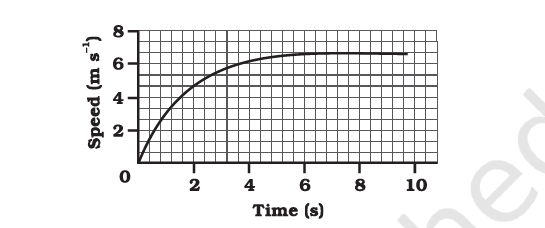
(a) Find how far does the car travel in the first 4 seconds. Shade the area on the graph that represents the distance travelled by the car during the period. (b) Which part of the graph represents uniform motion of the car?
(a)
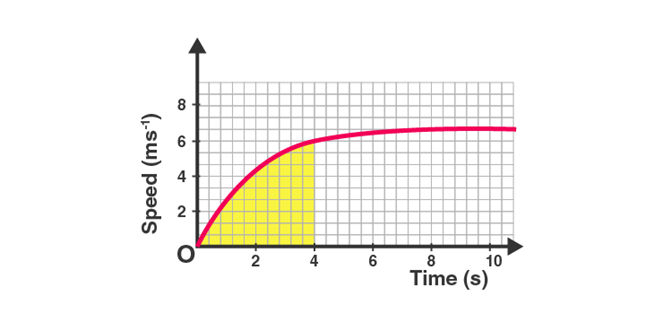
The shaded area represents the displacement of the car over a time period of 4 seconds. It can be calculated as:
(1/2)*4*6 = 12 meters. Therefore the car travels a total of 12 meters in the first four seconds.
(b) Since the speed of the car does not change from the points (x=6) and (x=10), the car is said to be in uniform motion from the 6th to the 10th second.
State which of the following situations are possible and give an example for each of these: (a) an object with a constant acceleration but with zero velocity (b) an object moving with an acceleration but with uniform speed. (c) an object moving in a certain direction with an acceleration in the perpendicular direction.
(a) It is possible; an object thrown up into the air has a constant acceleration due to gravity acting on it. However, when it reaches its maximum height, its velocity is zero.
(b) it is possible; acceleration implies an increase or decrease in speed, and uniform speed implies that the speed does not change over time
Circular motion is an example of an object moving with acceleration but with uniform speed.
An object moving in a circular path with uniform speed is still under acceleration because the velocity changes due to continuous changes in the direction of motion.
(c) It is possible; for an object accelerating in a circular trajectory, the acceleration is perpendicular to the direction followed by the object.
shows the distance-time graph of three objects A, B and C. Study the graph and answer the following questions:
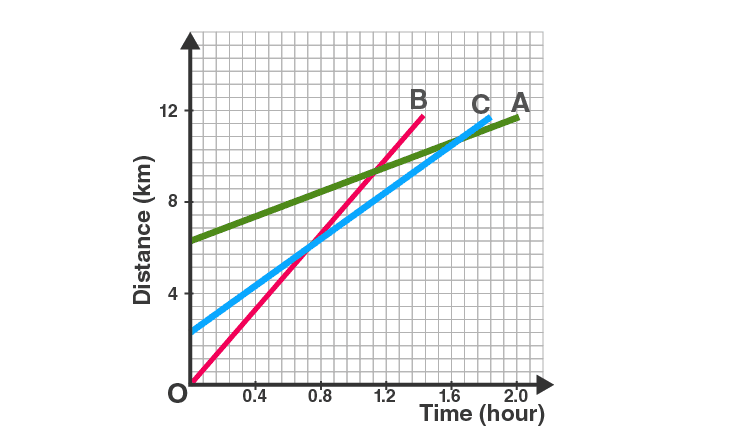
(a) Which of the three is travelling the fastest? (b) Are all three ever at the same point on the road? (c) How far has C travelled when B passes A? (d) How far has B travelled by the time it passes C?
(a) Since the slope of line B is the greatest, B is travelling at the fastest speed.
(b) Since the three lines do not intersect at a single point, the three objects never meet at the same point on the road.
(c) Since there are 7 unit areas of the graph between 0 and 4 on the Y axis, 1 graph unit equals 4/7 km.
Since the initial point of an object C is 4 graph units away from the origin, Its initial distance from the origin is 4*(4/7)km = 16/7 km
When B passes A, the distance between the origin and C is 8km
Therefore, total distance travelled by C in this time = 8 – (16/7) km = 5.71 km
(d) The distance that object B has covered at the point where it passes C is equal to 9 graph units.
Therefore, total distance travelled by B when it crosses C = 9*(4/7) = 5.14 km
What is the quantity which is measured by the area occupied below the velocity-time graph?
Considering an object in uniform motion, its velocity-time graph can be represented as follows.
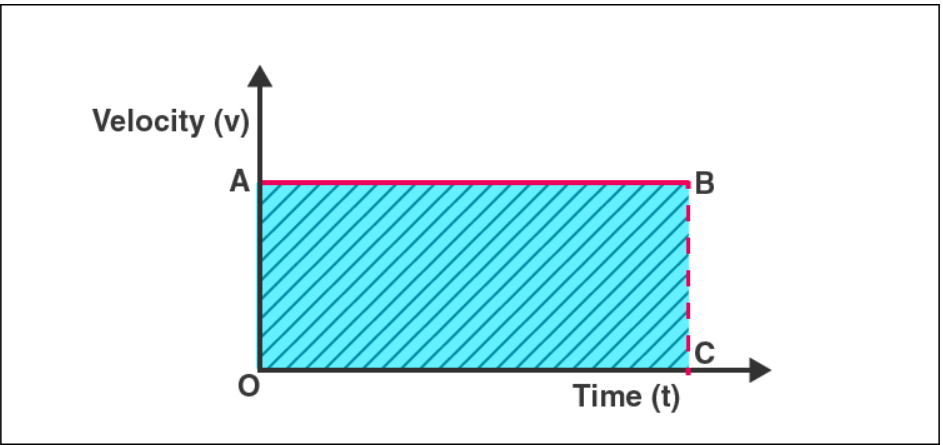
Now, the area below the velocity-time graph is the area of the rectangle OABC, which is given by OA*OC. But OA is the velocity of the object and OC represents time. Therefore, the shaded area can be represented as:
Area under the velocity-time graph = velocity*time.
Substituting the value of velocity as displacement/time in the previous equation, it is found that the area under the velocity-time graph represents the total displacement of the object.
What can you say about the motion of an object whose distance-time graph is a straight line parallel to the time axis?
The distance-time graph can be plotted as follows.
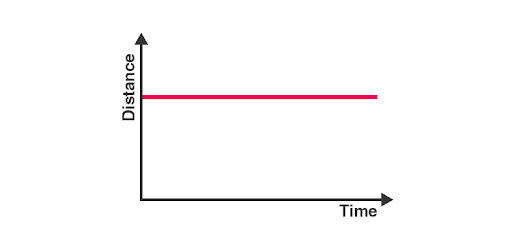
When the slope of the distance-time graph is a straight line parallel to the time axis, the object is at the same position as time passes. That means the object is at rest.
What can you say about the motion of an object if its speed-time graph is a straight line parallel to the time axis?
The speed-time graph can be plotted as follows.
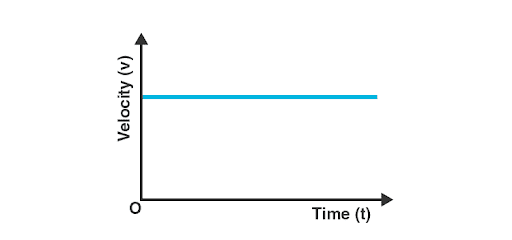
Since there is no change in the velocity of the object (Y-Axis value) at any point of time (X-axis value), the object is said to be in uniform motion.
What is the nature of the distance-time graphs for uniform and non-uniform motion of an object?
For uniform motion, the distance-time graph is a straight line. On the other hand, the distance-time graph of an object in non-uniform motion is a curve.
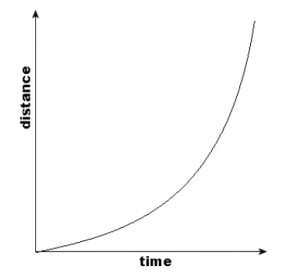
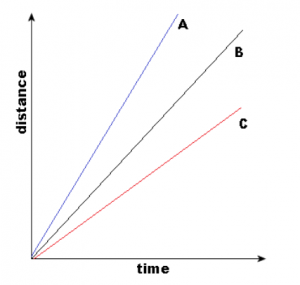
The first graph describes the uniform motion and the second one describes the non-uniform motion.
A driver of a car travelling at 52 km h–1 applies the brakes and accelerates uniformly in the opposite direction. The car stops in 5 s. Another driver going at 3 km h–1 in another car applies his brakes slowly and stops in 10 s. On the same graph paper, plot the speed versus time graphs for the two cars. Which of the two cars travelled farther after the brakes were applied?
The speed v/s time graphs for the two cars can be plotted as follows.
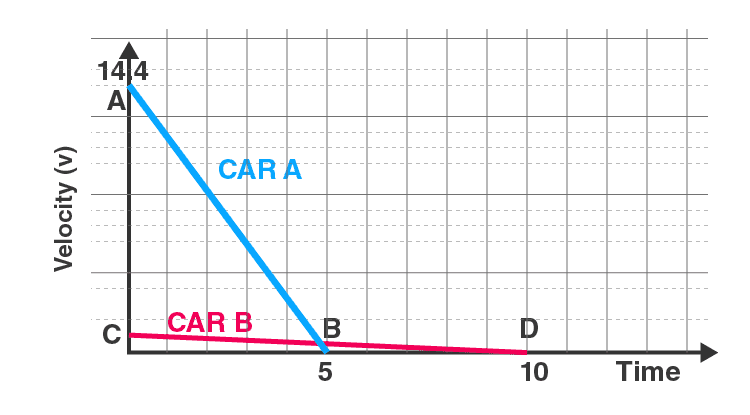
The total displacement of each car can be obtained by calculating the area beneath the speed-time graph.
Therefore, displacement of the first car = area of triangle AOB
= (1/2)*(OB)*(OA)
But OB = 5 seconds and OA = 52 km.h-1 = 14.44 m/s
Therefore, the area of the triangle AOB is given by: (1/2)*(5s)*(14.44ms-1) = 36 meters
Now, the displacement of the second car is given by the area of the triangle COD
= (1/2)*(OD)*(OC)
But OC = 10 seconds and OC = 3km.h-1 = 0.83 m/s
Therefore, area of triangle COD = (1/2)*(10s)*(0.83ms-1) = 4.15 meters
Therefore, the first car is displaced by 36 meters whereas the second car is displaced by 4.15 meters. Therefore, the first car (which was traveling at 52 kmph) travelled farther post the application of brakes.
Frequently Asked Questions
The NCERT solution for Class 9 Chapter 7: Motion is important as it provides a structured approach to learning, ensuring that students develop a strong understanding of foundational concepts early in their academic journey. By mastering these basics, students can build confidence and readiness for tackling more difficult concepts in their further education.
Yes, the NCERT solution for Class 9 Chapter 7: Motion is quite useful for students in preparing for their exams. The solutions are simple, clear, and concise allowing students to understand them better. They can solve the practice questions and exercises that allow them to get exam-ready in no time.
You can get all the NCERT solutions for Class 9 Science Chapter 7 from the official website of the Orchids International School. These solutions are tailored by subject matter experts and are very easy to understand.
Yes, students must practice all the questions provided in the NCERT solution for Class 9 Science Chapter 7: Motion as it will help them gain a comprehensive understanding of the concept, identify their weak areas, and strengthen their preparation.
Students can utilize the NCERT solution for Class 9 Science Chapter 7 effectively by practicing the solutions regularly. Solve the exercises and practice questions given in the solution.

